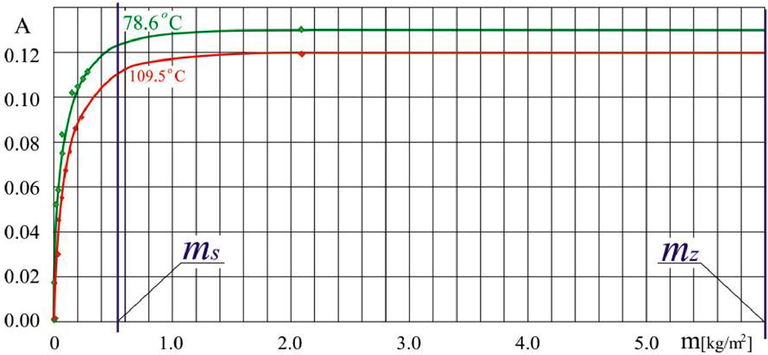TLDR: Jest praktycznie dowiedzione naukowo, że zwiększanie stężenia dwutlenku węgla w atmosferze Ziemi nie powoduje zwiększania średniej temperatury na naszej planecie.
TLDR: It is practically scientifically proven that increasing the concentration of carbon dioxide in the Earth's atmosphere does not increase the average temperature on our planet.
Wpadło mi w ręce niezwykle ciekawe badanie naukowe trzech polskich fizyków (Jan Kubicki, Krzysztof Kopczyński, Jarosław Młyńczak), którzy przeprowadzili serię eksperymentów mających na celu sprawdzenie zdolności absorpcji promieniowania przez dwutlenek węgla.
I came across an extremely interesting scientific study by three Polish physicists (Jan Kubicki, Krzysztof Kopczyński, Jarosław Młyńczak), who conducted a series of experiments to test the ability of carbon dioxide to absorb radiation.

Okazuje się, że ten gaz osiąga swoje maksimum absorpcyjne przy masie około 0,5-0,7 kg na metr kwadratowy powierzchni, w zależności od temperatury ciała emitującego promieniowanie (im wyższa temperatura, tym większa masa dla maksimum absorpcyjnego). Czyli dla promieniowania wtórnego Ziemi to maksimum osiągalne jest przy stężeniu CO2 w atmosferze około 10-krotnie niższym od obecnego (masa CO2 w atmosferze to 3x10^15 kg, powierzchnia Ziemi to 5,1x10^14 m2, wychodzi niecałe 6 kg/m2). Dalsze zwiększanie zawartości CO2 nie przekłada się w żadnym stopniu na zwiększenie temperatury uzyskanej z tej części efektu cieplarnianego, za który odpowiada dwutlenek węgla. Oczywiście, to będzie inaczej wyglądać przy wielokrotnie większej masie atmosfery (jak na Wenus) oraz przy znacznie wyższych temperaturach powierzchni planety emitującej promieniowanie, ale różnice rzędu kilku czy kilkudziesięciu stopni jak widać nie mają tutaj znaczącego wpływu.
It turns out that this gas reaches its absorption maximum at a mass of about 0.5-0.7 kg per square meter of surface, depending on the temperature of the body emitting the radiation (the higher the temperature, the greater the mass for the absorption maximum). That is, for the Earth's secondary radiation, this maximum is achievable at a CO2 concentration in the atmosphere about 10 times lower than the current one (the mass of CO2 in the atmosphere is 3x10^15 kg, the surface of the Earth is 5.1x10^14 m2, which is less than 6 kg/m2). Further increase in CO2 content does not affect in any way the increase in temperature obtained from this part of the greenhouse effect, for which carbon dioxide is responsible. Of course, it will look different with a much larger mass of the atmosphere (like on Venus) and with much higher temperatures of the planet's surface emitting radiation, but differences of a few or several dozen degrees, as you can see, do not have a significant effect here.
Dla weryfikacji wniosków z eksperymentu, autorzy przeprowadzili kolejny, w którym zbadali stopień absorpcji promieniowania emitowanego przez rozgrzaną powierzchnię Księżyca (powierzchnia naszego satelity pod wpływem promieniowania Słońca nagrzewa się do 110 C). Promieniowanie to, gdy dociera do powierzchni Ziemi, ma wcześniej kontakt z atmosferą i ulega w niej pochłanianiu. Naukowcy zbadali, czy po przejściu przez pojemnik z dodatkowym dwutlenkiem węgla, promieniowanie to ulegnie w jakimś stopniu dalszemu pochłanianiu. Otóż, okazuje się że tak się nie dzieje. Już w atmosferze Ziemi promieniowanie Księżyca ulega maksymalnemu pochłanianiu i dalsze zwiększanie jego ekspozycji na dwutlenek węgla nic nie zmienia.
To verify the conclusions from the experiment, the authors conducted another one, in which they examined the degree of absorption of radiation emitted by the heated surface of the Moon (the surface of our satellite heats up to 110 C under the Sun's radiation). When this radiation reaches the Earth's surface, it first comes into contact with the atmosphere and is absorbed in it. Scientists have examined whether after passing through a container with additional carbon dioxide, this radiation will be further absorbed to some extent. Well, it turns out that this does not happen. Already in the Earth's atmosphere, the Moon's radiation is absorbed to the maximum and further increasing its exposure to carbon dioxide does not change anything.

Co ciekawe, okazuje się, że poniekąd zajmujemy się wyważaniem dawno otwartych drzwi. Zjawisko, w skrócie mówiąc efektu cieplarnianego CO2 zostało zauważone już przez szwedzkiego uczonego Arrheniusa w 1896 roku, który miał nadzieję, że odpowiednio intensywna emisja tego gazu doprowadzi do pożądanego przez niego ocieplenia klimatu, a tym samym zapewni ludziom lepszy poziom egzystencji (większe plony, mniejsze koszty ogrzewania). Jednak już 1900 roku hipotezę Arrheniusa podważył Ångström, który zauważył zjawisko nasycenia gazu absorbującego. Następnie, w 1972 r. Schack na podstawie swoich rozważań wykazał, że przy ówczesnym stężeniu 0,03% dwutlenku węgla w powietrzu proces absorpcji w troposferze jest już nasycony (obecne stężenie CO2 w atmosferze to 0,04%).
Interestingly, it turns out that we are in a way engaged in forging doors that were opened long ago. The phenomenon, in short the greenhouse effect of CO2, was noticed by the Swedish scientist Arrhenius in 1896, who hoped that the appropriately intensive emission of this gas would lead to the desired warming of the climate, and thus provide people with a better standard of living (higher crops, lower heating costs). However, in 1900, Arrhenius' hypothesis was challenged by Ångström, who noticed the phenomenon of saturation of the absorbing gas. Then, in 1972, Schack, based on his considerations, showed that at the then concentration of 0.03% of carbon dioxide in the air, the absorption process in the troposphere is already saturated (the current concentration of CO2 in the atmosphere is 0.04%).
Autorzy przypominają też badanie z 2013 roku (Humlum i in., 2013), które wykazało, że szczyty cyklicznych zmian stężenia atmosferycznego CO2 poprzedzane są szczytami cyklicznych zmian temperatury powietrza i wody na całym świecie. To oznacza, że zawartość dwutlenku węgla w atmosferze rośnie w efekcie wzrostu temperatury (dwutlenek węgla pod wpływem ciepła jest uwalniany z oceanów), a nie CO2 powoduje wzrost temperatury.
The authors also recall a 2013 study (Humlum et al., 2013) that showed that peaks in cyclical changes in atmospheric CO2 concentration are preceded by peaks in cyclical changes in air and water temperature worldwide. This means that the content of carbon dioxide in the atmosphere is increasing as a result of the increase in temperature (carbon dioxide is released from the oceans under the influence of heat), and not CO2 causing the increase in temperature.
Link do badań w języku angielskim:
Link to the study:
https://www.sciencedirect.com/science/article/pii/S2666496823000456?via%3Dihub#bib0026
Na wykresie: ustalone w badaniach masy nasycenia CO2 dla badanych temperatur ciała emitującego promieniowanie (ms) i masa CO2 na Ziemi dla porównania (mz).
On the graph: the CO2 saturation masses determined in the studies for the tested temperatures of the body emitting radiation (ms) and the mass of CO2 on Earth for comparison (mz).

@tipu curate 8
Upvoted 👌 (Mana: 0/65) Liquid rewards.
Hello dysydent!
It's nice to let you know that your article will take 12th place.
Your post is among 15 Bestszejq articles voted 7 days ago by the @hive-lu | King Lucoin Curator by
You receive 🎖 0.6 unique LUBEST tokens as a reward. You can support Lu world and your curator, then he and you will receive 10x more of the winning token. There is a buyout offer waiting for him on the stock exchange. All you need to do is reblog Daily Report 494 with your winnings.
Buy Lu on the Hive-Engine exchange | World of Lu created by szejq (Lucoin) and get paid. With 50 Lu in your wallet, you also become the curator of the @hive-lu which follows your upvote.
STOPor to resume write a wordSTART